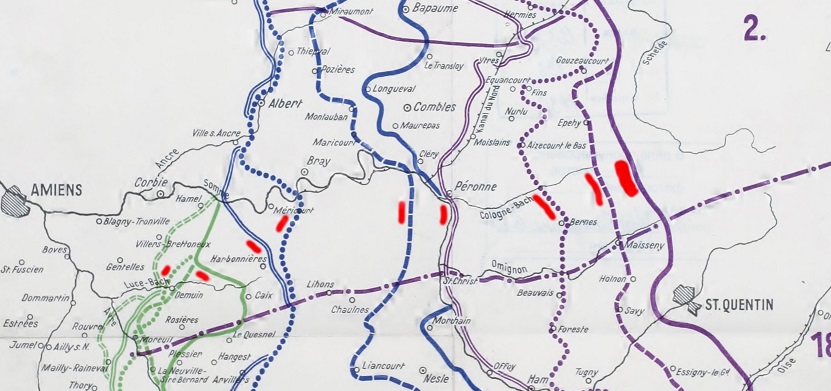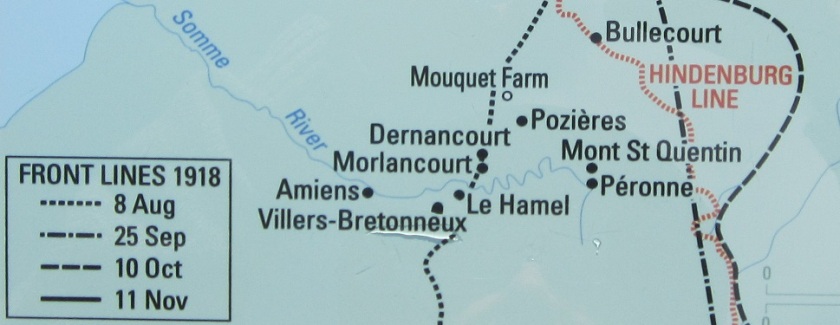It is now said (by Australian Government publicists), that Australia’s most significant contribution to victory in the First World War was made on the Western Front in France and Belgium between 1916 and 1918. This was when “Australian forces engaged the main enemy on the main battlefront and made an appreciable difference to the outcome”.
We celebrate the Dardanelles campaign and the ‘ANZAC legend’ for other reasons. As far as I can see New Zealand and Australian troops did not act in unison on the Western Front.
This is not saying ‘Australia won the war’ but rather that it advanced its section of a very large line, using our own skills, tactics and leadership, often with great courage and sacrifice of lives.
The major battles (read ‘loss of life’) for Australia, were at Passchendale, Pozieres, Bullecourt and Fromelles. Victory is a relative term, most had appalling losses to both sides and moved the line a matter of miles.These all occurred before 1918 and therefore were outside the primary scope of our visit, although we may go to some of these sites in time.
Our focus is on the battles of 1918 which occurred as part of the wider ‘Somme Offensive’ and are notable as they contributed towards a final Armistice which ended the war in November 1918.
In particular General (Sir) John Monash’s decisive 4 July 1918 victory at Le Hamel, while relatively small in comparison to some other battles, became regarded as a text-book example of innovative tactics and meticulous planning, combining tanks, aircraft, artillery and mobile ground troops that became the template for the much larger operations that followed.
The towns that saw the ‘heaviest fighting’ for Australians in pushing back the German advance in 1918 include Villers Bretoneaux, Mont St Quentin-Peronne and Hamel. Smaller ones include Albert and Corbie. However skirmishes occurred over a wide area, for example, our tiny hamlet of Lavieville has 6 Australian dead in its cemetery.
The position of the front-line between Germany and the Allies moved frequently throughout 1918. In simple terms in early 1918, the Germans, using troops relieved from the Russian Front and fearing the impact of newly arrived American troops, had a major push towards Amiens and Paris and advanced through about half of the region shown in the map below. They were then driven back by British, French, Australian, New Zealand and American troops in the period from April to October.

Below is the best map I can find of the extent of the early German advance. It covers the period 21 March to the 4th May shown as purple, blue and green lines, moving left towards Amiens. Unfortunately it does not show the full extent of the Germans’ advance later that month which includes the capture of Villers Bretonneux using gas attacks (which alone caused 1000 Australian casualties) and tanks. The Germans hardly used tanks in comparison to the Allies; this this encounter in Mid-May was the first tank on tank battle of WW1. On their second attempt, Australian troops recaptured Villers Bretonneaux in April 25th (ANZAC day) following extremely vicious and heroic fighting, including the wining of 2 VCs.

The below image (taken from the display at the Australian War memorial on the hill outside Villers Bretonneux) shows the Allied advance from August to September in the other direction. With the breaching of the major defensive Hindenburg line the Germans were steadily falling back. Suffering war weariness and civil unrest the Kaiser abdicated. The Armistice took effect on 11 November 1918.

This overall movement for all Allies along the entire Western Front in 1918 can be seem below, with the initial German advance deeper into France on the left, with the subsequent Allied advance towards Germany on the right. Paris, lower left, is a useful reference point. On these maps Australia, Canada and New Zealand appear in the fine print.

